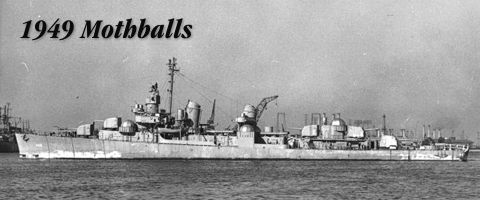|
| |||||||||||||||||
|
When wars end and ship crews are reduced by discharge, the Navy has a lot of useless
On 26 March 1949, Nicholas was re-designated an escort destroyer, DDE 449. She was reconfigured and recommissioned 19 February 1951. |
So, at war's end, the Navy evaluates its warships and sells some to other nations to beef up their navies; gives some to cities to be restored and serve as war memorials; and refurbishes and preserves some, puts them in mothballs as it were, in case of another war.
That mothballing process at the end of World War II and the demothballing process at the beginning of the Korean War were done largely by each ship's own crew, bolstered by experts from the civilian sector to ensure that all equipment is in working condition: engines, boilers, electronic equipment, weapons, galley, everything.
During the early stages of the mothballing process, the crew lives aboard, cleaning, polishing, chipping, painting, oiling, removing items for storage. Later, they move ashore and return to the ship on a daily basis.
Some items are removed from the ship and put into appropriate storage ashore. Ammunition is stored in bunkers ashore. Food is assigned to active units for consumption. Pistols, rifles, and other small weapons go to gunnery storage. Binoculars, long-glasses, sextants, and the like go to optical storage. Chronometers go to quartermaster storage.
Large-caliber weapons—5-inch/38, 40-millimeter, 20-millimeter cannons—are cleaned and oiled and left in place. Ship's clocks in the various compartments are allowed to run down, but remain in place. Radio, sonar, and radar equipment are cleaned, inside and out, tested for operation, and covered. Engines and boilers are tested for operation, and cleaned and greased and oiled. Gauges and polished, and brightwork shined. Compartments are cleaned to spotlessness. Bilges are pumped and hand wiped dry. Paintwork throughout the ship, inside and out, is cleaned, chipped, and repainted.
As the mothballing process nears the end, the crew moves ashore, returning aboard each day only to perform the remaining work.
Now that the vessel is as shipshape as it can be, two actions remain: sealing and preventing rust.
All watertight doors are dogged down and all outside vents are closed. All guns are covered with painted canvas. Every seam—watertight doors, vents, canvas-to-deck—is sealed with a soft compound that hardens over time. Finally, every sealed space is filled with a nitrogen mixture to prevent rust. The ship is no longer in commission.
Mothballed ships are moored in large numbers alongside piers and each other in various ports. Round-the-clock watches maintain security. No one is allowed aboard any mothballed ship.
Until the next war.
« « «
The demothballing process is the reverse of the mothballing process. The nucleus of a new crew—the ratings, not the seamen and firemen—is assigned, because they are needed to make the ship operational. Initially, they are billeted ashore because the ship is uninhabitable.
The crew's first task is to remove the sealing compound from watertight doors and vents and seams and open all spaces to allow air to replace the nitrogen mixture. Only then may they move aboard into their assigned bunks and spaces.
As soon as possible, they light off the boilers and test the engines; they turn on the electronic equipment and assure their operation. Everything is tested for operation. Of course, the cannon are not fired in port. That must wait for the shakedown cruises after the ship is fully manned and in operation.
Eventually, seamen and firemen are assigned and formed into working parties to return equipment from storage: small arms, optical equipment, chronometers, whatever is needed to make the ship functional as a warship. Food is struck below, and the galley is lit off.
Meanwhile, quartermasters and radiomen are assigned to bring up to date all of the navigation and communication publications needed to operate a modern warship, recording all of the changes and corrections since the books were last corrected and changed. That task alone can take several weeks.
The whole process requires several weeks, but since several ships are being demothballed at the same time, whole divisions and squadrons are readied, seemingly at once.
The last process before standing out for the war zone involves the cannons and ammunition. Loading ammunition takes place at Mare Island in San Francisco Bay. The run up the coast is used for shakedown.
The run to the war zone is used to shake down the weapon systems.
By then, the crew is tested and ready. The ship is battle-ready.
— Doug Starr
|



